Suspended ceilings in the domestic market of building materials appeared in the early 90s. Since then, they have gained tremendous popularity. Conducted to be a number of benefits: attractive form, ease of installation, reliability and practicality. Using them you can hide communications passing on the ceiling, for example, ventilation box or wiring. Suspended ceilings are used in the finishing of rooms with different purposes.
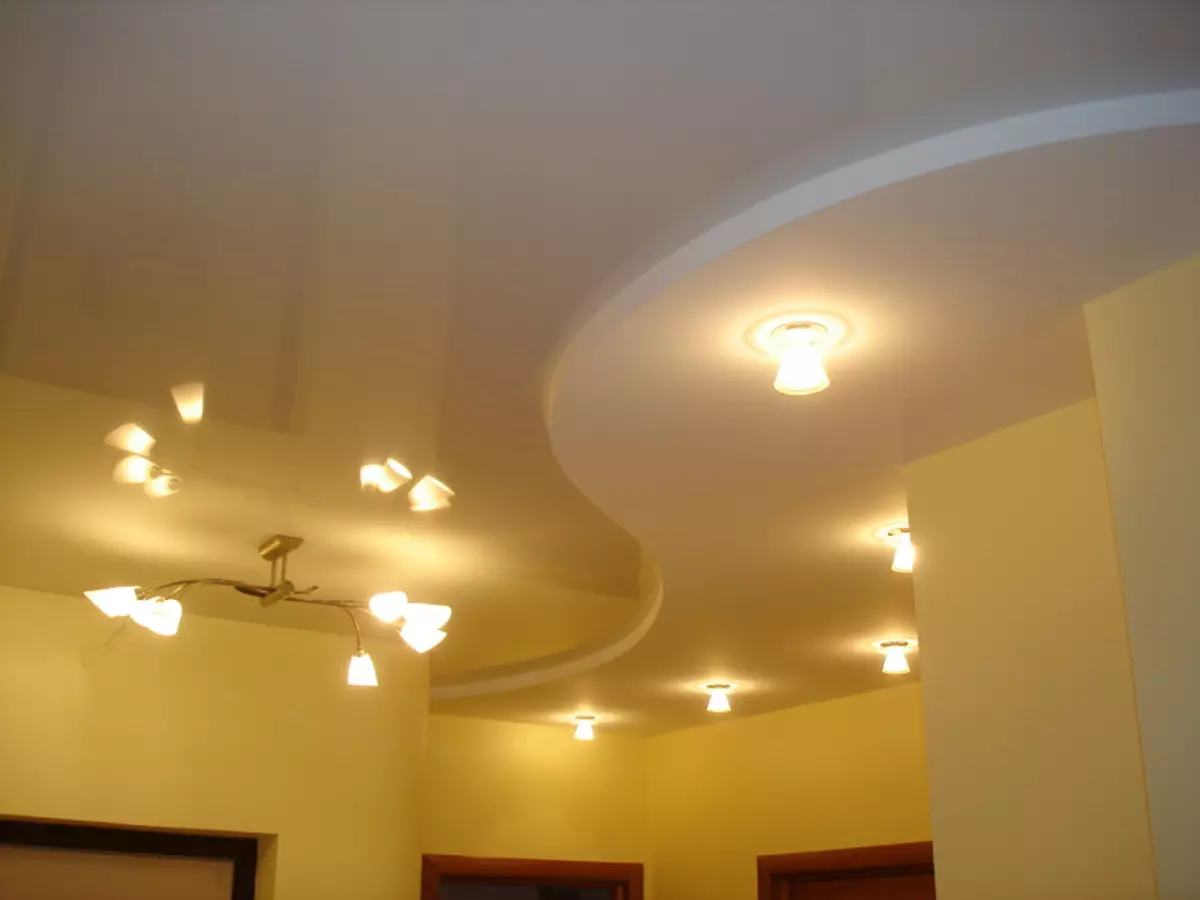
The designs of the suspended ceilings make it possible to realize any fantasies and ideas of the owners of apartments and houses.
Today, the suspension (or stretched) ceiling is an integral part of the interior of trading halls, offices, restaurants, etc. In addition to the decorative function, their use contributes to the creation of good acoustics and optimal microclimate conditions.
Currently, depending on which material is used in the manufacture, as well as structural features, the following types of suspended ceilings are distinguished:
- Gypsum and plasterboard;
- cassette;
- mirrored;
- Glass.
Next will be given a more detailed feature of the most popular species to date so that it is possible to compare them.
Construction, application and advantages of gypsum and drywall suspended ceilings
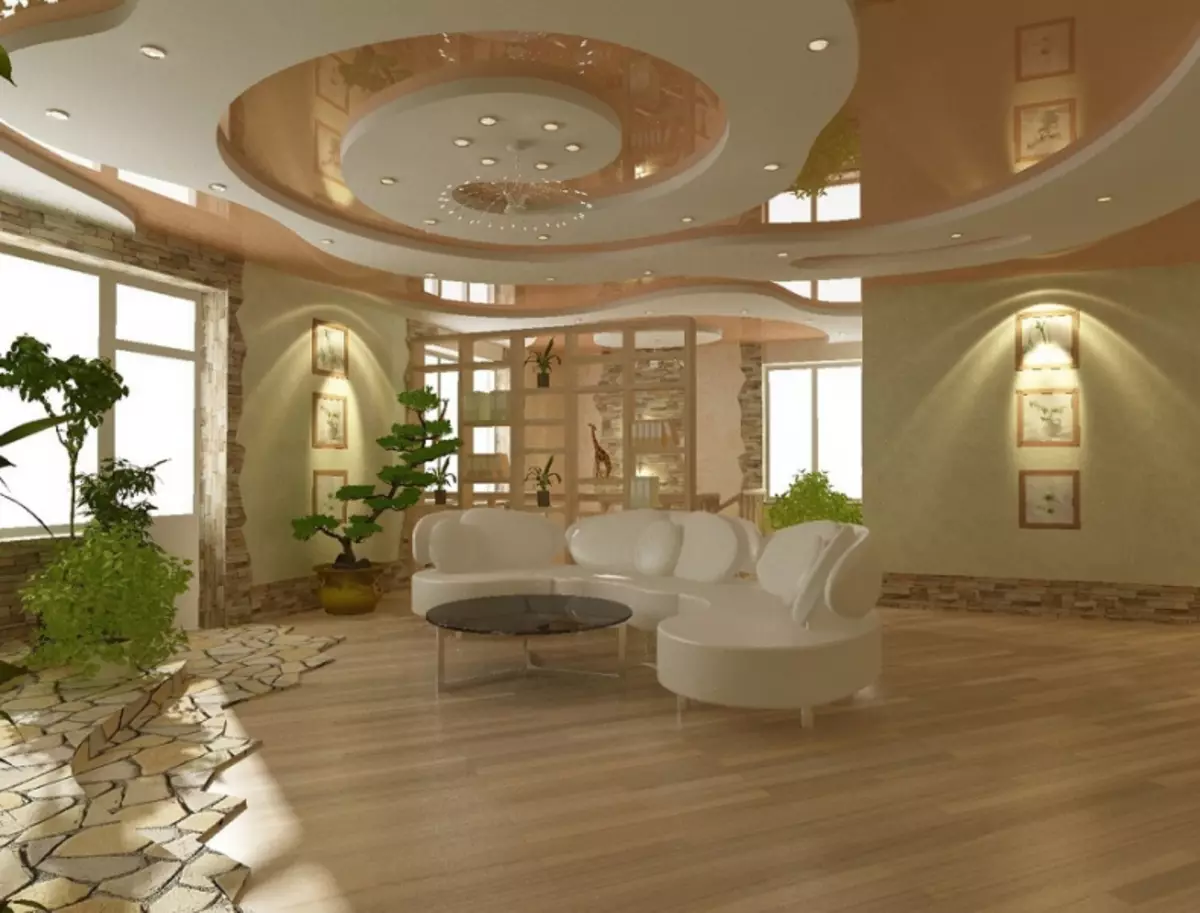
Plasterboard is very flexible, which allows you to render any necessary geometric shapes.
They provide an opportunity to effectively issue various premises. Their use is advisable both in residential buildings and in public institutions: hospitals, beauty salons, exhibition halls, etc. Gypsum ceilings can be used to create an interior in any style due to a wide range of reliefs. The most spectacular look they have in the premises of a large area. The variety of types of panels allows you to pick them up for both the premises in the style of the ancient palace and modern interiors. Plasterboard plates are used to create acoustic ceilings or to give the interior of the room more modern species.
Constructively, such ceilings consist of plates (they are also called panels) mounted on the suspension system. She in turn is attached to overlaps. The title already states that the plaster is the main material that is used in the manufacture of such plates. To give greater physical strength, they can additionally reinforce with fiberglass grid. In plasterboard plates, a sheath of cellulose is used to give stiffness.
Depending on the weight, they are usual and lightweight. Facility relief is achieved due to the special production technology, in which the material is dried, forming granules. The appearance of the panels can be smooth, embossed or perforated. In the process of forming a suspended ceiling, you can combine different types of panels. As a result, you can create a decorative surface having a wide variety of drawings.
Article on the topic: Is it possible to glue wallpaper for plasterboard: the rules of preparation and sticking
Advantages of using this type of ceilings
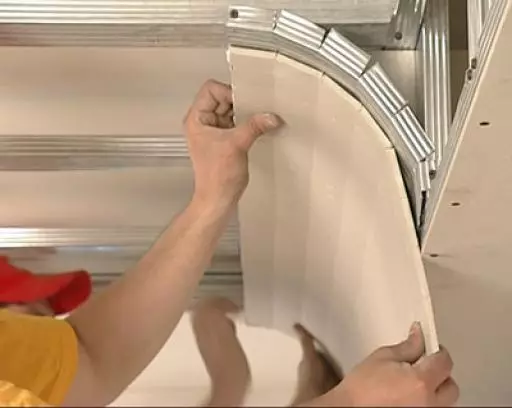
Plasterboard is an environmentally friendly material, not lit, does not contain toxins and cannot cause allergies.
Gypsum, like products from it, has the following advantages:
- High ecology. This material is natural, and therefore safe. This property allows the use of gypsum and plasterboard plates in medical institutions.
- High degree of reflection. It can reach 80%, which allows not to use additional lighting during the daytime.
- Decorativeness. A variety of models and their attractive appearance allow you to create interiors in almost any style.
- High sound insulation. Its species is determined by the type of panels: perforated absorb sound, and smooth - reflect.
- High fire resistance. This material is non-combustible, which allows the use of such plates in rooms, where fire safety requirements are quite large.
- Operational installation. It is ensured due to the fact that no pre-training of overlaps is required. Installation takes just a few hours.
Due to the fact that ordinary and moisture-resistant plates options are produced, they can be awarded both the ceiling of rooms with normal humidity, and with elevated, for example, in the bathroom.
The use of cassette ceilings, their design and advantages
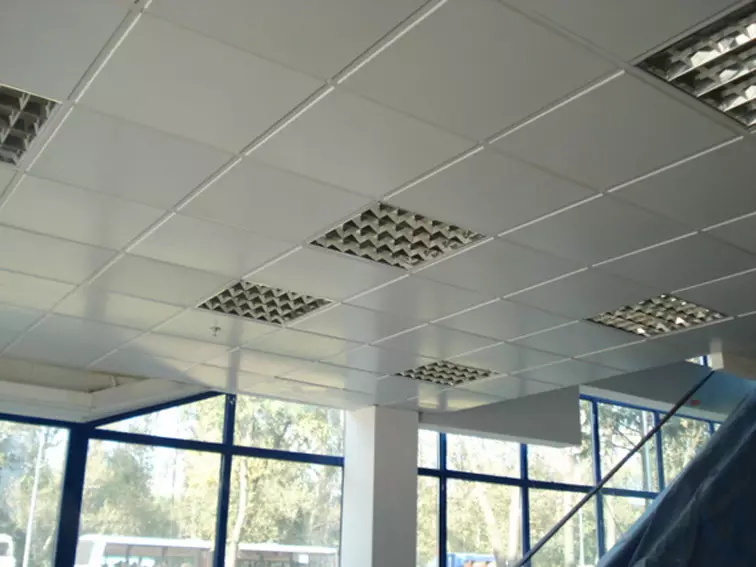
The main advantage of cassette suspended structures is the possibility of installing any type of lighting and communications climate control.
Structurally, this type of suspended ceiling consists of a cassette, in the manufacture of which the following materials can be used: aluminum with bimetallic coating and metallic galvanized rental. The technology of their processing is somewhat different. Aluminum cassettes are polished with the use of chemicals, which makes it possible to achieve a mirror glitter, and galvanized rental is painted using powder mixtures. At the base of the ceiling is the suspension system.
It consists of basic and transverse guides, aveden corner and adjustable suspensions. In the manufacture of all its elements, steel or aluminum is used. As you know, these materials have high resistance to the corrosive exposure of moisture and are able to withstand the destructive effect of various chemicals. Due to this, the entire design of cassette suspended ceilings is under reliable protection.
Very often to meet them in office premises, shops, restaurants, laboratories and even pools. In the latter case, their use is advisable due to high resistance to moisture. They can be applied to decorate residential premises, most often bathrooms. The range of application of the coating of this type is quite wide, which is due to its technical and operational characteristics.
Advantage of using this design
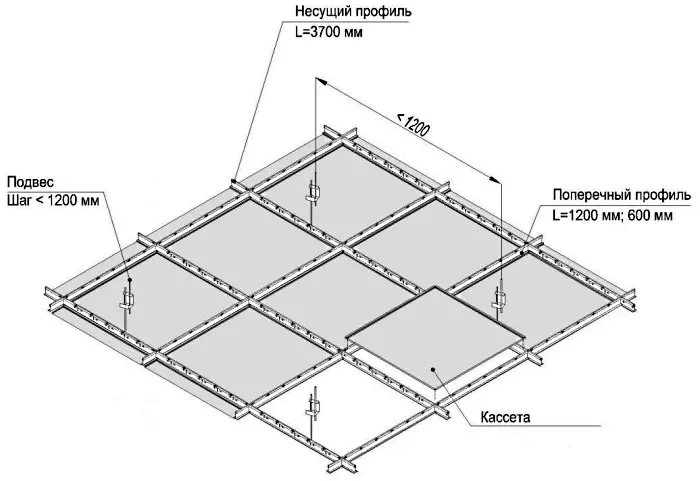
Mounting cassette ceiling circuit.
Very important advantage for designers who do not have such an extent the remaining types of suspended ceilings are the ability to set the lighting of any type and communications of climate control. To do this, it is enough to dismantle only one panel. In addition, such ceilings have the following advantages:
- Ease of installation. The whole design is going very quickly and also quickly disassembled if it is necessary to dismantle. If you need to replace one element, it is not necessary to dismiss the entire ceiling.
- Long service life. Materials used in the manufacture are capable of maintaining their indicators for a long time than this advantage.
- High degree of hygienicness. Such a ceiling is enough to wipe with a dry or damp cloth. Due to the fact that the material has a chemical structure, resistant to the appearance of fungi and mold, the use of them is advisable in medical institutions.
- Resistance to moisture. A coating consisting of several layers reliably protects materials from the destructive impact of moisture.
- High fire resistance due to an extremely low ignition.
Article on the topic: Curtains from tissue residues are beautiful
Comparison of the considered types of suspended ceilings
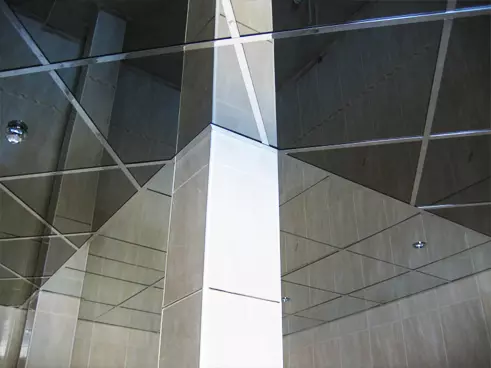
Glass and mirror ceilings visually increase the height of the room, due to the reflection.
Above the characteristics of glass and mirror structures was not presented. It is determined by the fact that they have the same design as cassette suspended ceilings. The only difference is the material used. Instead of metal, the glass and mirror are used accordingly. The technical and performance indicators are quite close to aluminum and galvanized metal.
By comparing the main advantages of various designs, you can see that they are very similar. Therefore, the expediency of using one or another type of ceiling has an influence mainly used material, its external quality and cost. Gypsum and drywall ceilings are most suitable for use in residential premises. It is determined by the fact that this material is natural, due to which a more cozy atmosphere is created. In addition, it is possible to create a truly unique relief on the ceiling. The remaining types of suspended ceilings are not able to provide such an opportunity.
In turn, cassette, mirror and glass designs allow for the best operational and practical properties. That is why they found wide use when making office space, restaurants, shopping centers, etc. If we consider from the point of view of the ease of installation, then plasterboard ceilings unequivocally have an advantage, because If you have certain skills to work with tools, it is possible to implement it on your own. Cassette ceilings to mount a non-professional is much more complicated. It is due to the fact that it is required to produce very accurate calculations, given the large number of indoor nuances.
Technology Mounting Ceiling Ceiling Carton Plate
First of all, you must apply an ideal horizontal band on the walls. To do this, use a level of 1.5-2 m or a hydroelectric background. A prerequisite is that the resulting line should be closed. The presence of displacements suggests that at some point the line is not carried out by level. After that, you can move to the markup of the attachment places of direct suspensions. If everything is done correctly, a peculiar grid will be applied to the ceiling, the sizes of the cells of which are 60x60 cm. Failure to comply with this size can be observed along the edges of the ceiling. In this case, the grid must be shifted so that the indents are symmetrically disposed.
After that, you can move to the consolidation of the guide profile, the standard length of which is 3 m. Fix it to the wall you need at least 4 places. Hats used dowel-nails must have a mushroom shape, due to which the profile contact with the wall is enhanced. This allows you to create a very reliable fastening. The guide profile must be docked without intervals.
Article on the topic: New York style in the interior
After the guide profile is mounted, you can go to the installation of the P-shaped suspension, which is installed on the previously applied markup. Since the weight of plasterboard sheets can have a deformation effect on the profile material, for greater gain, the P-shaped suspension is installed on both sides of the joint.
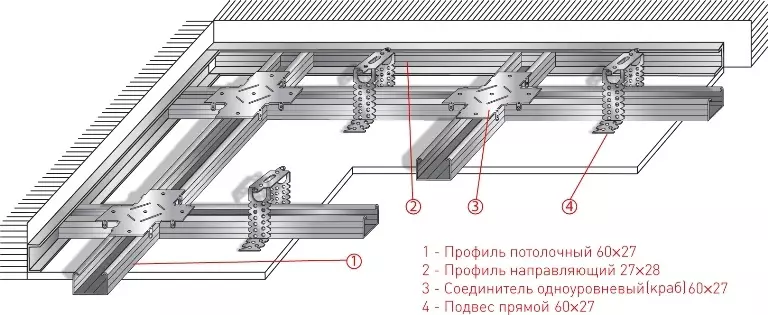
Suspension scheme for plasterboard.
The next step is to install the ceiling profile, which is carried out from one wall to another. In this case, it is inserted into the guide profile. Since the type of carrying design is not ideal, the ceiling profile is attached to P-shaped suspensions, but the horizontal level is checked. In the intervals are set to shorter profile segments. The fasteners are carried out using a crusade. If the lengths of the profiles are not enough, they can be connected using special connectors.
After the entire profile is fixed on the ceiling, you can move to the mounting of drywall on the resulting frame. In this case, one-piece sheets are mounted perpendicular to the long guide. At this stage should be resorted to assistance to perform the work of the most qualitatively. This procedure is performed using self-samples.
Proper cutting of plasterboard sheet
The material used is rather fragile, so it is necessary to comply with precautions when working with it, so as not to spoil the sheet. First you need to put markup, for which a long rail is used or rule. After that, over the markup line, a sharp construction knife is cut into a depth of about 4 mm. The resulting line should not have breaks and be smooth. Next, it is necessary to break a piece of drywall for incision. It is done with a neat, but confident movement on the edge of a table or another smooth surface. If everything is done correctly, the break point will be smooth.Brief conclusions
The use of suspended ceilings, as well as tension, in our country began relatively recently. But due to the fact that with their manufacture, high-quality and easy-to-use materials are used, they received quite widespread. Currently, at home, during repair, the ceiling is used made of gypsum and plasterboard plates. However, in some rooms, such as bathroom, the use of cassette suspended ceilings is also relevant.
Plasterboard ceilings are distributed due to broader opportunities to create a embossed decorative surface and ease of installation. The main difficulty in carrying out this procedure is to constantly withstand the horizontal level.
Thus, it can be seen that the use of this technology is now very relevant. It is mainly due to the advantages that are provided to the consumer, among which is an excellent decorative appearance, reliable material and practicality.
